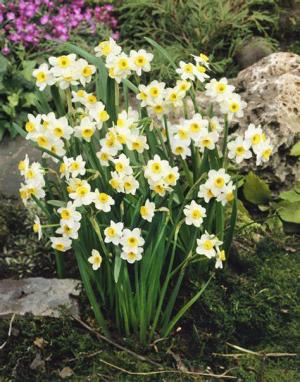Tazetta daffodils are good naturalizers, and will happily increase and form clumps of flowers over the years
We know minnows as very small bait fish, but the SS Minnow of “Gilligan's Island” fame was actually named not for the tiny fish, but as a reference to Newton Minow, chairman of the Federal Communications Commission, who once called American television "a vast wasteland."
You won't find yourself stranded if you plant Minnow daffodils. Like all members of the Tazetta Narcissus family, Minnow is a robust, multi-flowering daffodil with several stems per bulb. Flowers of Tazetta daffodils contain a fragrant compound found in very few other plants, including roses.
The Minnow daffodils bloom with white petals that surround small, buttercup-yellow centers. The petals open with light shades of yellow, and turn pale white as they mature. Minnow produces three to five blooms on each stem. Tazetta Daffodil Minnow is hardy in USDA Zones 4-9.
All of this comes in a miniature size, only reaching eight to 10 inches high. For all-yellow Tazetta daffodils, try the very fragrant Golden Dawn, with light yellow-green flowers and white highlights. Golden Dawn has an orange cup whose color gets deeper as the flowers mature.
Deer rarely eat daffodils, so these hardy small flowers should last a long time. Small daffodils are perfect for borders, rock gardens and beds, and for planting out under trees. They also are great for forcing into bloom when potted up and brought indoors. If you are forcing them, you will need to chill them in the refrigerator for about four weeks. Because of their fragrance, they are popular for cut flowers.
Best of all, Tazetta daffodils are good naturalizers, and will happily increase and form clumps of flowers over the years.
Plant Minnow, Golden Dawn and other Tazetta narcissus where they will get full sun or light shade. Plant them under deciduous trees that will not leaf right away, and so will let sunlight reach the daffodils.
Dig the soil down to about 10 inches deep and plant the tiny bulbs six inches deep and four to six inches apart. Daffodils look best when clustered in groups of at least five bulbs. After planting, be sure to water deeply. They will grow in almost any soil, whether acidic, clay or rich garden loam, as long as it drains well. Soggy soil will rot bulbs.
After your Tazetta daffodils have bloomed in late April, let the leaves mature and die down naturally. The leaves need to soak up sunshine and minerals from the earth to provide nourishment for next year’s flowers.
All daffodils need at least one inch of water per week when they are actively growing and blooming, so if the spring weather is very dry, water them once a week.
You can also fertilize established beds of daffodils by applying a slow-release organic bulb formula fertilizer when growth first starts in spring, and again after the flowers have faded.
Your Tazetta daffodils will become reliable perennials that return year after year in ever-greater numbers. When planted in masses, they create stunning drifts of color.
So plant bulbs for Tazetta daffodils, and sit back and enjoy reruns of “Gilligan's Island.” As you ponder the timeless appeal of small flowers, remember that “Gilligan's Island” was written as a satire to show that people of different backgrounds could work together and get along. Ironically, the opening scene was filmed right after John F. Kennedy was assassinated, which is why you can see the American flags are at half mast as the Minnow goes out of Hawaii on its three-hour tour.























































